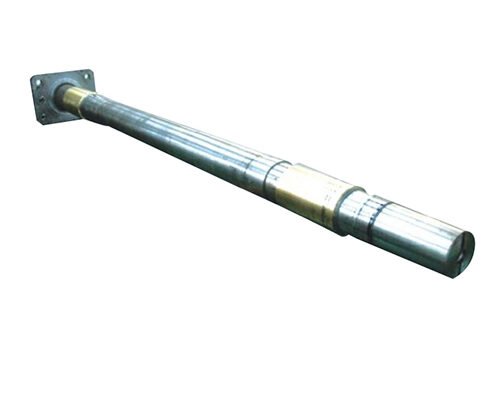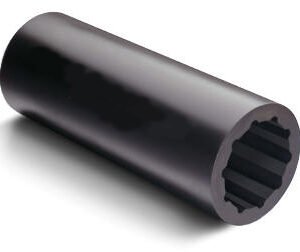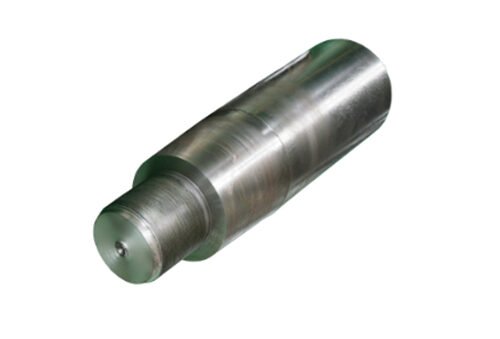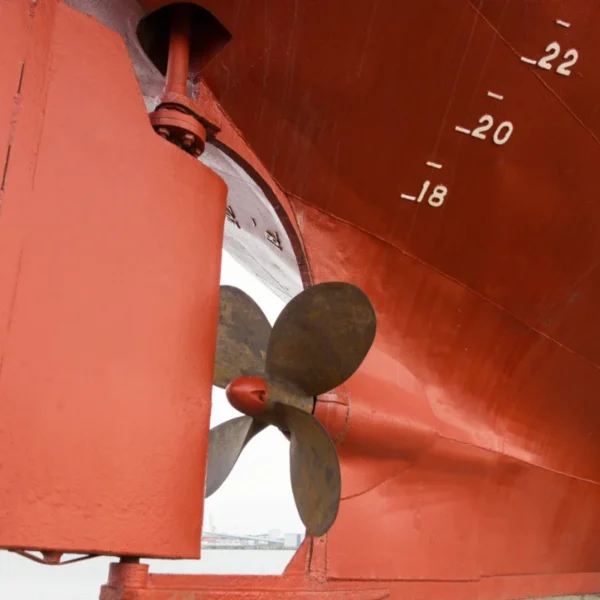The rudder stock is a crucial component of a ship’s steering system, serving as the main vertical shaft that connects the rudder blade to the steering gear. It is the structural backbone of the rudder assembly, responsible for transferring the immense force from the steering gear to the rudder blade and supporting the rudder’s weight and all the hydrodynamic forces acting upon it.
Function and Importance
The rudder stock’s primary functions are:
- Power Transmission: It receives the rotational force (torque) from the steering gear, which is located in the steering gear room, and translates it into the turning motion of the rudder blade.
- Structural Support: It supports the weight of the rudder blade, transferring this load to the rudder carrier bearing (also known as the rudder stock bearing), which is a thrust bearing located on a deck or bulkhead within the vessel.
- Force Absorption: It must be strong enough to withstand the combined bending, shear, and torsional stresses caused by the water flowing against the rudder blade.
Components and Design
The rudder stock itself is a single, large, high-strength component, but it is part of a larger assembly.
- Rudder Stock: A solid or hollow forged steel shaft. Its design, including its diameter and material properties, is carefully calculated by naval architects to handle the maximum forces it will encounter in service.
- Rudder Carrier Bearing: This bearing, which is often a plain bearing or a roller bearing, supports the entire weight of the rudder assembly. It is a critical component for ensuring smooth, low-friction rotation.
- Seals: A stuffing box or a specialized seal is fitted where the rudder stock passes through the hull to prevent seawater from entering the steering gear room.
- Tiller: The rudder stock is connected to the steering gear via a tiller or a similar mechanical connection that allows the steering gear to turn the stock.
- Pintle Connection: The rudder stock is connected to the rudder blade at its lower end, and often supported by a pintle bearing below.
Maintenance and Common Issues
Given its critical function, the rudder stock is subject to rigorous inspection and maintenance.
- Bearing Wear: The rudder carrier bearing, which supports the full weight of the rudder, is a high-wear component. Excessive bearing wear can lead to a “rudder drop” and vibration.
- Sealing: The integrity of the rudder stock seals must be regularly checked to prevent water ingress into the steering gear room.
- Fatigue Cracks: The rudder stock is exposed to cyclical stresses, which can lead to fatigue cracks over time. These are typically checked using non-destructive testing (NDT) methods like magnetic particle inspection during dry-docking.
- Corrosion: While the rudder stock is typically well-protected, corrosion can occur, particularly in areas where coatings are damaged.
Common Spares
A vessel’s spare parts inventory for the rudder stock focuses on wearable components and sealing elements.
- Rudder Carrier Bearing: Spare bearing inserts or a complete new bearing unit.
- Rudder Stock Seals: A complete kit of new seals, including lip seals and O-rings.
- Packing Material: If a traditional stuffing box is used, spare packing material is required.
- Mounting Hardware: Spare bolts and nuts for the tiller and bearing housing.
The rudder stock is a non-negotiable safety component that requires unwavering attention to maintenance to ensure the safe and reliable steering of the vessel.
We offer an extensive range of marine engine brands and their associated spare parts, providing comprehensive solutions for both main propulsion and auxiliary power needs across diverse vessel types. Our supply capability covers various generations and models, ensuring support for a wide array of marine applications.
Featured Brands and Engine Series/Models:
SULZER:
- Two-Stroke Engines:
- RD/RND Series: RD68, RND76, RND76M, RND90, RND90M (Classic large-bore, low-speed engines, still in operation).
- RLA/RLB Series: RLA(B)56, RLA(B)66, RLA(B)76, RLB90 (Developed two-stroke designs).
- RTA/RT-Flex Series: RTA38, RTA48(T), RTA52, RTA58, RTA62, RTA72, RTA76, RTA84, RTA84M, RTA84C, RTA96 (Modern, fuel-efficient, electronically controlled two-stroke engines).
- Four-Stroke Engines:
- Z Series: ZL40/48, 16ZAV40S (Medium-speed engines).
- RF Series: RF44, RF56 (Often used for auxiliary power or generator sets).
- TAD Series: TAD36, TAD48 (For specific applications).
MAN (including pre and post-MAN B&W models):
- Two-Stroke Engines (KZ, KSZ, K, L, S, MC/MC-C, ME/ME-C): 40/54A, 52/90N, 57/80C, KZ57/80F, KSZ70/125, KSZ78/155, 90/160A, 52/55L, 58/64, 90/190C, L60/105E, 70/120E, 70/125C, L, KSZ78/155A, KSZ70/125B, L52/55A, 40/45 (A broad spectrum covering main propulsion and auxiliary engines).
B&W (Burmeister & Wain – prior to MAN B&W merger):
- MC/MCE Series: L35MC, L60MC, L80MC, L55GFCA, L80GFCA, L80GB, 74VT2BF, K62EF, K74EF, K84EF, K45GFC, K67GFK, K80GFK, K90GFS, 45HU, L70MC (Various generations of two-stroke diesel engines).
- MC-C/ME-C Series: L50MC, S60MC, S70MC, K80MC, S80MC, K90MC-C, L67GFCA, L90GB (Electronically controlled and conventional two-stroke engines).
- VT2BF/EF Series: 50VT2BF, 62VT2BF, K84EF (Older models still in service).
MITSUBISHI:
- UEC/UET Series: UEC37L/LA/LS, UEC45HA, UEC60L/LA/LS, UEC45L/LA/LS, UET45/75C, UEC52/125H, UEC52L/LA/LS, UET45/80D, UEC52/90D, UEC(T)52/105D, UEC45/115H, UEC37/88H, UEC37H (Mitsubishi’s proprietary two-stroke and some four-stroke engine series).
PIELSTICK:
- PA Series: PA6, PC3, PC2-2, IHI PC2-5, PC4, PC2-6, PC4-2L, PC4-570, PA5 (High-speed, compact four-stroke engines, commonly used for generator sets or auxiliary propulsion).
AKASAKA:
- UET/UEC/DM/AH Series: UET45/80D, UEC52/105D, DM51SS, UEC 60/150H, UEC 60H, A31, A34, A37, A41, AH27, AH28, AH30, AH36, AH38, AH40, DM30, DM36, DM38, DM46, DM47 (A prevalent engine brand, particularly in Japanese-built vessels).
DEUTZ:
- RBV/TBD/BVM Series: RBV8M358, RBV8M540, RBV16M640, TBD620L6, BVM350, BVM540, BF6M716 (Various four-stroke medium- and high-speed diesel engines for auxiliary and smaller main propulsion applications).
HANSHIN:
- EL/LH/LU/LUN/LUD/LUS Series: EL30, EL32, EL35, EL40, EL44, LH28RG, LH31G, LU28(A,R,G), LU32, LU35, LU38, LU46(A), LU50, LU54, LUN28, LUN30, LUD32, LUD35, LUS38 (Another significant engine brand commonly found in Japanese vessels).
NIIGATA:
- MG/M Series: MG40X(EX), M34X, 6M28BF, TM31X (Medium-speed diesel engines, typically used in small and medium-sized vessels).
MAK:
- M/MU/AK/AKM Series: M332, M453AK, MU551AK, MU552AK, M601, MU452AK, 451AK, 6M453AK, 9M453C, 6M601C, 8M601 (Medium-speed four-stroke engines, widely used in various marine applications).
WARTSILA:
- 20/22/26/32/38/46/GD/TKR Series: 22, 32, 31, 26, 20S, 28, 38, 46, 32GD, 46GD, 14, TKR22, HFR-V32, NOHAB (Wärtsilä’s broad portfolio of medium- and high-speed diesel engines for main propulsion, auxiliary, and generator sets).
DAIHATSU:
- PS/PKT/DS/DL/DK/PL Series: PS-18, PS-22, PS-20, PS-26, PS-30, PKT-14, PKT-16, PKTD-16, DS-18, DS-22, DS-26, DS-28, DS-32, DL-14, DL-16, DL-19, DL-20, DL-22, DL-24, DL-26, DK-20, PL-24 (Compact and reliable engines primarily used for auxiliary power and generator sets).
CUMMINS:
- BT/CT/NT/KTA/QSK/QSM Series: 4BT3.9, 6BT(A)5.9, 6CT8.3, NT(A)855, N14, KTA19, KTA38, KTA50, QSK19, QSM11 (Robust and durable engines for marine auxiliary power, generator sets, and some smaller main propulsion applications).
CATERPILLAR:
- 3000/3100/3300/3400/3500/3600 Series & C Series: 3054, 3056, 3066, 3106, 3126, 3306, 3406, 3408, 3412, 3508, 3512, 3516, 3606, 3608, 3612, 3616, 3618, C1.5, C2.2, C7, C9, C10, C12, C15, C16, C18, C30, C32 (Reliable and widely used engines across a vast range of main propulsion, auxiliary, and generator set applications).
SCANIA:
- DI Series: DI 09, DI 13, DI 16 (High-performance diesel engines designed for marine applications, typically used as auxiliary and smaller main propulsion engines).




